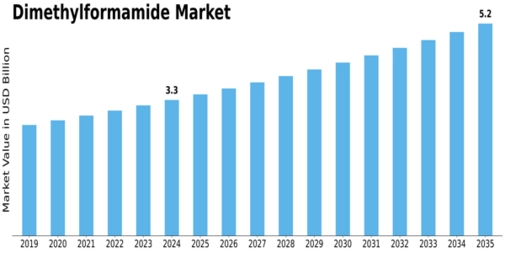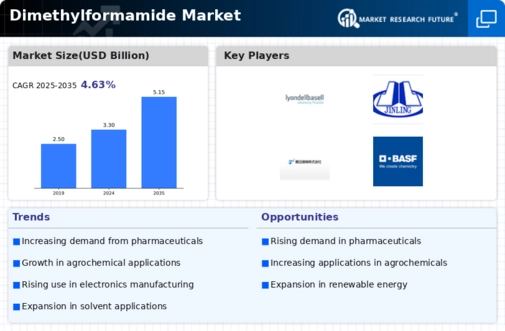Growth in Agrochemicals
The Global Dimethylformamide Market Industry is significantly influenced by the agrochemical sector, where Dimethylformamide is utilized as a solvent in the production of pesticides and herbicides. The increasing global population and the consequent demand for food security drive the need for effective agrochemical solutions. As agricultural practices evolve, the reliance on chemical solutions to enhance crop yields becomes more pronounced. This trend suggests a robust growth trajectory for Dimethylformamide, contributing to the overall market expansion. The compound's versatility in formulating agrochemicals positions it as a key player in addressing agricultural challenges.
Market Trends and Projections
The Global Dimethylformamide Market Industry is characterized by evolving trends and projections that highlight its growth potential. The market is expected to reach a value of 3.3 USD Billion in 2024, with a projected increase to 5.15 USD Billion by 2035. This growth trajectory is indicative of a compound annual growth rate (CAGR) of 4.14% from 2025 to 2035. Key drivers influencing this trend include rising demand in pharmaceuticals, agrochemicals, and electronics manufacturing. As industries continue to innovate and expand, the role of Dimethylformamide remains pivotal in various applications, shaping the future of the market.
Rising Demand in Pharmaceuticals
The Global Dimethylformamide Market Industry experiences a notable surge in demand from the pharmaceutical sector. Dimethylformamide serves as a solvent in the synthesis of various pharmaceutical compounds, enhancing the efficiency of drug formulation processes. As the global pharmaceutical market expands, driven by increasing healthcare needs and innovations, the demand for Dimethylformamide is projected to grow. This trend is reflected in the anticipated market value of 3.3 USD Billion in 2024, with expectations to reach 5.15 USD Billion by 2035. The compound's role in drug development and production underlines its importance in the pharmaceutical landscape.
Increasing Use in Polymer Production
The Global Dimethylformamide Market Industry is bolstered by its application in polymer production, particularly in the synthesis of polyacrylonitrile and other polymers. These materials are essential in various industries, including textiles and automotive. The growing demand for lightweight and durable materials drives the need for efficient polymer production processes. As the market for polymers expands, the role of Dimethylformamide as a solvent and reaction medium becomes increasingly critical. The compound's contribution to enhancing polymer properties indicates a positive outlook for its market presence, aligning with the projected CAGR of 4.14% for 2025-2035.
Advancements in Electronics Manufacturing
The Global Dimethylformamide Market Industry benefits from advancements in electronics manufacturing, where Dimethylformamide is employed as a solvent in the production of electronic components. The rise of smart devices and the Internet of Things (IoT) has led to increased demand for high-quality electronic products. Dimethylformamide's properties facilitate the production of semiconductors and circuit boards, enhancing the performance and reliability of electronic devices. As the electronics sector continues to innovate, the demand for Dimethylformamide is likely to grow, further solidifying its role in the manufacturing process.
Environmental Regulations and Sustainability Initiatives
The Global Dimethylformamide Market Industry faces challenges due to stringent environmental regulations aimed at reducing hazardous chemical usage. While Dimethylformamide is effective in various applications, its environmental impact necessitates the exploration of safer alternatives. This regulatory landscape may influence market dynamics, prompting manufacturers to innovate and adopt greener practices. Companies are likely to invest in research and development to create sustainable solutions that align with regulatory requirements. Although this presents challenges, it also opens avenues for growth in the market as industries seek to comply with environmental standards.








Leave a Comment